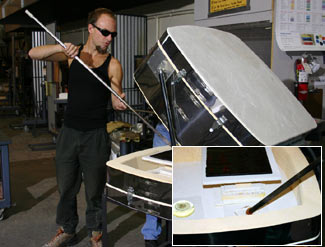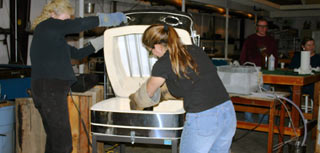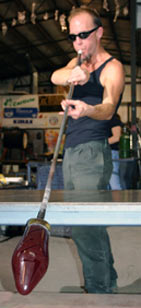
Picking up the chunk of clear Bullseye for the punty
 Putting away the piece for annealling
Putting away the piece for annealling |
Johnathon Schmuck
The Roll Up technique of glassmaking involves warm,
hot, and cold methods all in unison. It is a technique for blowing glass
without the furnace of molten glass; all that is required to blow a Roll
Up is a glory hole and a kiln.
One begins with sheets of colored compatible
glass; each color is compatible with all the other colors for fusing and
for melting. These sheets are cut up into strips or pieces and arranged
into patterns on a kiln shelf. These patterns are placed into a kiln and
heated to a light melt so the all the pieces of glass will fuse into a
flat tile. After cooling, the tile is coldworked to clean the bottom surface
and define the edges that will be the seam. The tile is then slowly reheated
in a kiln on a ferro (actually a small kiln shelf) to a point where the
glass is hot enough to be removed from the kiln without cracking; it is
then quickly heated more in the glory hole until the tile is soft. When
the tile is heated and ready, a moil (the glass collar on the blowpipe)
is stuck onto the top edge of the tile, and the tile is Rolled up, just
as sheet of paper might be rolled into a tube. The tile is then reheated
and moved around until the edges of the seam are joined, smooshed, and
melted together. The piece is then formed into a cylinder, which is later
closed off at the end to make a bubble. This bubble is then blown out,
puntied, and opened up -- in similar fashion to other glass blowing operations.
The main consideration with the Roll Up technique
is the extreme delicacy of the blowing operation - it requires a constant,
active dialogue with the piece of glass. The whole process enables one
to produce precise and very intricate designs in the glass, which are unachievable
with furnace glass. These patterns can be formed of pure color with great
depth and allow for the design of different patternings on both the inside
and the outside of the vessel. These designs can cause problems though,
as there can be drastic viscosity issues in the glass, eg. when a soft
color (one that heats up quickly) is adjacent to a hard color (that heats
up slowly), it tends to make the piece much trickier to control. The main
difficulty is that many pieces do not blow out evenly, and one often has
to futz around to keep the piece on center, of even thickness, and round
-- concerns that are often minimal when blowing with furnace glass, where
the clear gather provides an thorough and stable layer. Roll Ups can easily
go out of sorts at the blink of an eye, with a bit much too time in the
glory hole or a too hard of a puff when blowing. Stretching a Roll Up can
also be pulse quickening.
After the successful blow, a piece is put back in
the kiln and cooled slowly to assure proper and full annealling of the
glass. The glass piece will then sit for a couple of days at room temperature
before is is ready to be cold worked -- diamond sawing, diamond-wheel cutting,
and wet-belt sanding allow the outer surface of the glass to be carved
and sculpted. These processes help to refine the form and the surface of
a piece until everything looks and feels right. The cold finishing becomes
another dialogue with the glass as the surface is removed, and the true
shape and finish of the piece is revealed.
The process usually involves first sawing
off punty, and flattening the bottom of the piece so it will stand properly.
The lip is made flat and then beveled. Rough places are smoothed, and undulations
might be added elsewhere. Most of the cold work starts with coarse wheels
and silicon-carbide belts; which are then replaced by finer-grained wheels
and belts as the surface of the glass is smoothed and refined. The piece
is finished by
 Initial blowing of the piece off the marver
Initial blowing of the piece off the marver |
hand lapping the surfaces with silicon-carbide
grit that is rubbed with sandpaper, or with diamond pads. The hand
lapping of the piece often takes several hours to finish, during which
the qualities of the surface of the glass are observed until a lustrous
texture, feel, and appearance areobtained. (Chemical treatments are rare.)
At a certain point, the piece finally seems that it is complete; everything
is as about right as it can get -- as seen in "...the idiom of the
American architect Louis Kahn, who, in working out the form of a building,
used to ask 'what the building wanted,' as if there were an internal drive,
or what later Greeks called an entelechy, and end state of fulfillment
in which the building found the form through which it fulfilled its being."
(Arthur C, Danto, After the End of Art, Princeton Press, 1997, pp. 105-6.)
Though the Roll Up technique is slow and methodical, and can be fraught
with technical hazard, I believe the final results begin to speak of this
fulfillment of being, especially when the piece is held in one's eyes and
seen with one's hands.
 |